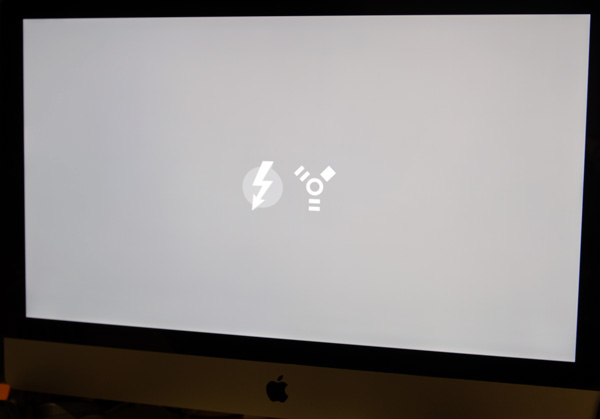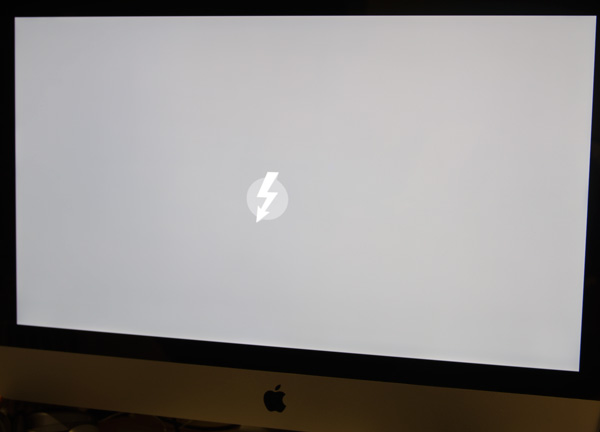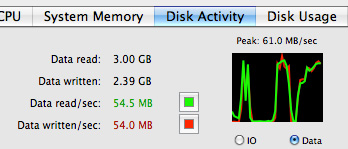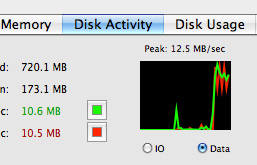Promise Pegasus R6 & Mac Thunderbolt Review
by Anand Lal Shimpi on July 8, 2011 2:01 AM ESTTarget Disk Mode
Another use of Thunderbolt is Target Disk Mode. Connect any two 2011 iMacs, 2011 MacBook Pros or any combination of the two with a Thunderbolt cable, reboot one of them while holding down the T key and you'll boot into target disk mode.

Hold down T and you'll get both Thunderbolt and FireWire logos at boot

With only Thunderbolt connected, the FireWire logo disappears - you're now in Target Disk Mode over TB
In this mode the target Mac boots into a special EFI state that allows all of its drives (HDDs, SSDs, optical, anything connected to the computer) to be mounted by the host Mac. The drives appear like normal removable disks on the host Mac:

MacBook Pro accessing the iMac's sole HDD over Thunderbolt in Target Disk Mode
You even have to eject them all manually before turning off the target Mac.
Don't get too excited though, since the target Mac isn't running full blown OS X it only implements basic storage drivers and optimizations. As a result, peak performance is no where near what Thunderbolt is capable of. Regardless of whether I put the 15-inch MacBook Pro or 27-inch iMac in target disk mode, I never saw more than 61MB/s from the target.

Performance was erratic as well. Sometimes I'd see transfer rates drop all the way down to 9MB/s before jumping up to 30MB/s and then 60MB/s. On average I'd say I saw transfers around 40MB/s.

The functionality is great, however I believe target disk mode would be a killer feature of Thunderbolt if it could operate at peak performance. In its current implementation, it's faster than a WiFi transfer but a bit slower than a good Gigabit Ethernet network transfer. If we could get line speed transfers, being able to move data between two modern Macs at multiple Gbps would be great.










88 Comments
View All Comments
Spazweasel - Friday, July 8, 2011 - link
$50 too much for a cable? Psshh. Children these days don't remember $75-100 SCSI-3 and UltraSCSI cables. These things are expensive for good reason.You want the highest performance, you pay to play. That's always been the case.
tzhu07 - Friday, July 8, 2011 - link
The phrase, "you get what you pay for" is generally true as a rule of thumb, but in the computer and consumer electronics industry, that has for the most part been untrue.Case in point: The high price of Monster cables having no performance advantage over the same type of cables one can find on newegg at a much lower price.
Apple just has this technology cornered....for now.
tzhu07 - Friday, July 8, 2011 - link
Well, I should say untrue in the computer and consumer electronics cable market.darwinosx - Friday, July 8, 2011 - link
The technology is Intel's not Apples. Intel determines the licensing fees.Samus - Friday, July 8, 2011 - link
Yes, but like SCSI, Apple was its only mainstream delivery vehicle. Back in the 80's and 90's, SCSI interfaces were reserved for servers, ultra high end workstations, and Apple computers. They always push the bleeding edge, which is possibly the only thing I respect about Apple.Justin Case - Saturday, July 9, 2011 - link
This has nothing to do with "pushing the bleeding edge". This has to do with giving Apple an "excuse" to remove USB ports from their iToys, thus locking out 3rd party accessory manufacturers (Thunderbolt is far too expensive to be competitive, unless you have a special deal like Apple has with Intel).The Mac hasn't been Apple's main focus for a long time; it's all about iOS and its ecosystem, now.
haley2011 - Sunday, July 10, 2011 - link
okMySchizoBuddy - Sunday, July 10, 2011 - link
doesn't the article specifically say that thunderbolt is free to license.Isn't Promise Pegasus a 3rd part manufacturer. Do you have any source claiming that Promise has a special deal with Apple.
Sony has thunderbolt ports in it's laptop as well.
Focher - Sunday, July 10, 2011 - link
Besides that you give away your bias of anything from Apple, TB isn't an Apple technology. It's an Intel one. What I find ironic is the USB versus TB arguments. First, it's a false choice. Even Apple has offered both FireWire and USB ports for years on their machines. It's only recently that FireWire has started to be removed from models. There's no current indication that USB will be dropped by Apple. Second, in specific regards to USB 3.0 I don't see the argument versus TB device availability. Neither have much market penetration yet, so only time will tell how each of them will do - and both could do fine or both could fail.MobiusStrip - Tuesday, July 12, 2011 - link
iOS devices are toys, but they already lack USB ports. They don't have any proper developer- or user-accessible I/O, so you think Apple's going to put Thunderbolt ports on them?NO. Apple has created a whole line of mobile devices that are ironically isolated from the world around them.